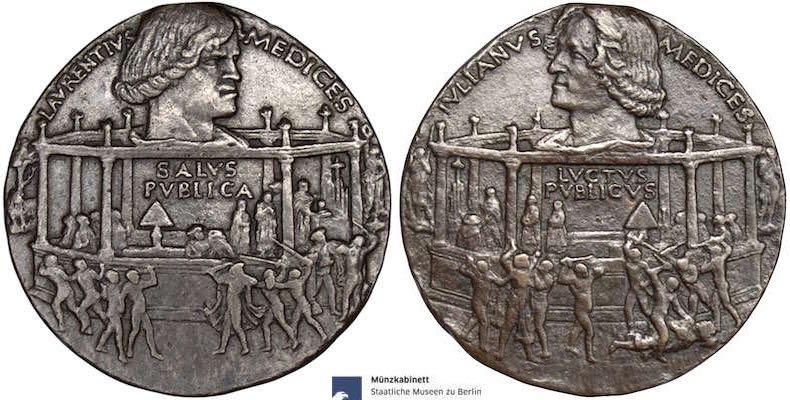The Pazzi Conspiracy
On 26 April 1478, the Medici were among the Catholic worshippers celebrating high mass at the Cathedral of Florence, Santa Maria del Fiore, commonly known as the Duomo. The ceremony was interrupted when a plot against the leading family resulted in the assassination of Giuliano de’ Medici (1453-1478) and the wounding of his brother Lorenzo de’ Medici, Il Magnifico, (1449-1492). Most likely at the moment when the priest elevated the Host, Giuliano was stabbed to death[1] while being called a traitor by members of the rival banking family, the Pazzi, and key conspirators.[2] Fortunately, Lorenzo was able to escape the same demise and hid behind the locked bronze doors of the cathedral’s north sacristy.[3] This blatant attack on Medici control within Florence known as the Pazzi Conspiracy, Congiura dei Pazzi, threw the city into upheaval. Anti-Medicean factions quickly lost control of their plan as pro-Medicean factions sought retribution for the bloodshed.[4] The subsequent hours and days after the conspiracy bore witness to violence in the name of justice. The Lord Priors and The Eight[5] oversaw the “spectacularly violent”[6] punishments of those found guilty. Some conspirators were killed and then thrown out of high windows for their bodies to be stripped and dismembered by the crowd, while others were hanged and left to be viewed before being cut down.[7] Messer Jacopo de’ Pazzi, the head of the household, was hanged a few days after the assassination and later buried in the family crypt. His body, however, was later exhumed and buried in unconsecrated city grounds where it was once again unearthed and dragged through the streets (weeks after his death) before being thrown in the Arno.[8] Few were granted exile.[9] In response to this coup d’etat the Medici seized Pazzi assets[10] and issued a damnatio memoriae against the treacherous family. The Pazzi Conspiracy and its aftermath were documented by contemporary historians and artists who created textual and visual images of this episode.
[1] Giuliano was reportedly stabbed twelve to nineteen times. Martines, Lauro. April Blood: Florence and the Plot against the Medici. New Ed., Oxford University Press, 2003, p. 116.
[2] Nethersole, Scott. Art and Violence in Early Renaissance Florence. Yale University Press, 2018, p. 39.
[3] Martines, April Blood, xi.
[4] “For all that the actions of the conspirators were brutal enough, they were but nothing when compared to the summary executions, marauding and revenge killings that followed.” Nethersole, Art and Violence, p. 39.
[5] Martines defines The Eight as “the much-feared office for rooting out and prosecuting political crime”. April Blood, p. 124.
[6] Nethersole, Art and Violence, p. 41.
[7] Martines, April Blood, pp. 125,
[8] Martines, April Blood, pp. 130-132.
[9] Scott Nethersole writes: “…the treatment of the Pazzi conspirators necessarily had to become spectacle to ensure that as many Florentines as possible could see the chilling wrath of Lorenzo and the otherwise invisible power of the government that he effectively controlled”. Art and Violence, p. 45.
[10] Martines, April Blood, p. 69.
YouTube Video:
The Plot to Kill the Medici: The Pazzi Conspiracy... by MedievalMadness
"15th century Florence was the epitome of a Renaissance city and home to some of the greatest philosophers, inventors and artists that have ever lived. A place full of new ideas, free thinking and beauty and also home to two families with tremendous wealth and power, the Pazzi’s and the Medici’s. On Easter Sunday 26th April 1478, a group of conspirators from the Pazzi family decided it would really like to destroy the Medici family and would start by murdering its two leaders Giuliano and Lorenzo. Of all the places for this vicious attack to take place it was the beautiful Florentine Cathedral during High Mass that was chosen and what followed was a bloodbath. Welcome to Medieval Madness." (Video desctiption).
